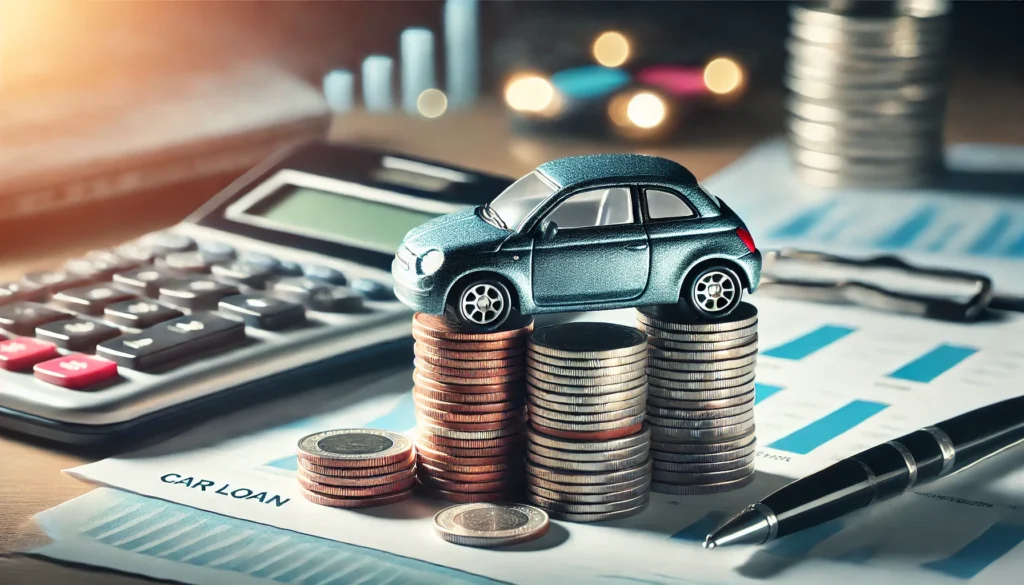The Importance of Understanding Car Loan Calculations for Smarter Budgeting
Purchasing a car is a significant financial commitment, and understanding how auto loan payments are calculated is crucial for effective budgeting. Many car buyers focus only on whether they can afford the monthly payment without fully considering how loan terms, interest rates, and the total cost of borrowing will impact their long-term financial situation. Financing a car can be a smart decision when done strategically, but failing to understand the financial mechanics of an auto loan can lead to unnecessary expenses and long-term financial strain.
By learning how to calculate a car loan payment, borrowers can make more informed financial choices and ensure that their purchase aligns with their budget and financial goals. Understanding how to figure out the interest rate on a car loan or how to compute total interest costs can prevent costly mistakes. Tools like a car payment calculator with sales tax can help provide an accurate estimate of monthly payments, ensuring that no hidden costs are overlooked.
Mastering the fundamentals of car loan calculations enables consumers to explore different financing options, negotiate better loan terms, and avoid common pitfalls such as high-interest financing or excessive loan durations. This guide will provide a detailed, step-by-step breakdown of car loan payment calculations, giving car buyers the knowledge they need to make financially sound decisions.
You May Also Like: Smart Strategies for Buying a Car: How to Navigate Auto Loan Financial Options and Save Big
How Car Loan Payments Are Calculated and Why It Matters
Car loans are typically structured as amortized loans, which means that monthly payments are fixed throughout the term of the loan. Each payment consists of two main components: principal and interest. The principal is the amount originally borrowed, while the interest is the cost charged by the lender for borrowing that money. In the early years of the loan, a larger portion of each payment goes toward interest, while later payments contribute more toward paying off the principal balance.
To estimate a car loan payment, borrowers need to know three key factors: the loan amount, the interest rate, and the loan term. The interest rate represents the percentage charged by the lender annually, while the loan term refers to the number of months over which the loan is repaid. A higher interest rate results in higher overall costs, while a longer loan term reduces monthly payments but increases the total interest paid over time.
For example, if a borrower takes out a $36,000 car loan at an interest rate of six percent over five years, they will pay a fixed monthly amount that includes both principal and interest. The total interest paid over the loan term can be calculated by multiplying the loan amount by the annual interest rate, then factoring in the number of years. By using an auto payment formula or an online calculator, borrowers can quickly estimate their total loan cost before signing an agreement.
Understanding how to find the interest paid on a car loan is crucial when deciding whether to refinance, make extra payments, or choose a shorter loan term. By evaluating different financing scenarios, buyers can determine the best loan structure to minimize interest costs and reduce their financial burden.

How to Figure Out Interest on a Car Loan and Minimize Costs
Interest is one of the biggest factors affecting the overall cost of a car loan. Many borrowers ask, “How do you calculate APR on a car loan?” or “How do you compute car loan interest?” The answer depends on the loan structure and how interest is applied over time.
Auto loans typically use simple interest, meaning that interest is calculated based on the remaining balance rather than being compounded. This means that each month, the interest amount is determined by multiplying the loan balance by the monthly interest rate. As the borrower makes payments, the loan balance decreases, which in turn reduces the interest charged on future payments.
For example, if a borrower has a $25,000 loan at five percent annual interest, they can estimate the total interest cost by multiplying the loan amount by the interest rate and then dividing it by the number of months in the loan term. This calculation helps borrowers understand how much interest they will pay over time and allows them to compare different financing options.
To reduce interest costs, borrowers should consider making larger down payments, opting for shorter loan terms, or improving their credit scores before applying for a loan. Making extra payments toward the principal can also help reduce the total interest paid by shortening the loan duration. By understanding how to compute car loan interest and exploring strategies to minimize it, borrowers can save thousands of dollars over the life of their loan.
Using a Car Payment Calculator with Sales Tax for More Accurate Estimates
Many car buyers overlook the impact of sales tax on their monthly loan payments. Since sales tax is applied to the purchase price of the vehicle, it can significantly increase the total amount financed. A car payment calculator with sales tax provides a more accurate estimate of the monthly payment by including tax in the loan amount.
Sales tax rates vary by location, and in some cases, taxes must be paid upfront rather than included in the loan. If a borrower chooses to roll sales tax into the loan, the loan principal increases, leading to higher monthly payments and interest costs. For example, if a car has a purchase price of $40,000 and the sales tax rate is eight percent, the total tax owed would be $3,200. If the tax is included in the loan, the loan balance increases to $43,200, resulting in higher payments over time.
By using a car loan payment equation that includes sales tax, buyers can see how tax impacts their overall loan cost and decide whether paying it upfront or financing it is the better option. Some lenders also charge fees or add-ons that should be factored into the total loan amount. Understanding these costs ensures that borrowers are fully prepared for their financial commitment.

How to Use an Auto Equity Calculator to Determine Loan-to-Value Ratios
Loan-to-value ratio, or LTV, is a critical factor in auto financing, as it determines how much a borrower owes on their car compared to its current market value. Using an auto equity calculator allows borrowers to estimate how much equity they have in their vehicle and whether they qualify for refinancing or trade-in options.
Lenders use LTV ratios to assess risk, with lower ratios indicating less risk for the lender. A lower LTV ratio may qualify borrowers for better refinancing terms, allowing them to lower their interest rate and reduce monthly payments. On the other hand, if a borrower owes more than the car is worth, they may be considered “underwater” on their loan, making refinancing difficult.
For example, if a car is worth $20,000 and the remaining loan balance is $15,000, the borrower has $5,000 in equity. This equity can be used toward a trade-in, loan payoff, or refinancing. Understanding how to figure out how much is owed on a car loan and how to calculate loan equity can help borrowers make smarter financial decisions.
By using an auto equity calculator, car owners can track their vehicle’s value and remaining loan balance over time. This information is valuable for deciding when to refinance, sell, or trade in a vehicle for a better financial position.

Frequently Asked Questions (FAQs): Mastering Your Auto Loan and Using the Car Loan Payment Formula
1. Why is it important to understand the car loan payment formula before financing a vehicle?
Understanding the car loan payment formula is essential because it allows borrowers to accurately estimate their monthly payments and total loan costs. By learning how to calculate car payment formulas, you can determine the financial impact of different interest rates, loan terms, and down payments. This knowledge helps prevent surprises when budgeting for a car and ensures that you select the most cost-effective financing option. It also enables borrowers to compare multiple loan offers and identify the best possible deal. Using a car payment calculator with sales tax further refines these estimates by accounting for state and local taxes.
2. How do you calculate APR on a car loan, and why does it matter?
To answer how you calculate APR car loans, you must consider both the interest rate and any additional fees, such as loan origination or processing charges. The Annual Percentage Rate (APR) represents the true cost of borrowing because it includes these extra costs, making it a more accurate reflection of loan expenses than the nominal interest rate. A higher APR means you will pay more in interest over time, even if the base interest rate seems low. Lenders are required to disclose the APR, but borrowers can also use a formula for auto loan calculations to verify and compare different offers. Understanding how APR affects long-term costs is crucial for securing the most favorable financing terms.
3. How do I figure out the interest rate on my car loan?
To determine how to find the interest rate on a car loan, you need to know the loan balance, monthly payment, and loan term. Lenders typically provide this information, but if you want to verify it, you can use a formula for calculating a car loan to reverse-engineer the interest rate. One way to estimate the rate is by dividing the annual interest cost by the loan balance and converting it into a percentage. Many borrowers use an auto equity calculator to assess whether refinancing could help secure a lower rate. A lower interest rate reduces monthly payments and total loan costs, making it a key factor in auto financing decisions.
4. What is the impact of loan term length on total interest paid?
A longer loan term results in lower monthly payments, but it also increases the total interest paid over the life of the loan. If you want to figure out car loan interest rates over different term lengths, you can use a monthly car payment formula to compare total costs. For example, a 36-month loan will have higher payments but significantly lower total interest than a 72-month loan. Using a car loan payment equation can help illustrate how different term lengths affect overall affordability. When selecting a loan term, it’s essential to balance monthly affordability with long-term savings.
5. How do I calculate how much I owe on my car loan?
To determine how much I owe on my car, you need to review your loan amortization schedule, which breaks down payments into principal and interest. As you progress through your loan, each payment gradually reduces the principal owed. You can also use an auto payment formula to estimate your remaining balance by factoring in the number of payments made and the interest paid so far. Some borrowers prefer using an online car loan equity calculator to assess their current loan balance versus the vehicle’s market value. Knowing your outstanding balance helps when considering refinancing or selling your car.
6. What role does sales tax play in determining my car payment?
Sales tax can significantly impact the final cost of a vehicle and must be factored into financing calculations. A car payment calculator with sales tax allows borrowers to determine the full amount due, including taxes, which vary by state and local regulations. Some states apply sales tax only to the financed portion of the vehicle, while others tax the total purchase price before trade-ins and incentives. Ignoring sales tax in budgeting can lead to higher-than-expected monthly payments. Using a formula for figuring car payments ensures that sales tax is accounted for in the overall loan calculation.
7. How do I figure out the total interest paid on a car loan?
To determine how to figure out the interest paid on a car loan, you need to calculate the cumulative interest accrued over the loan term. One method is to multiply the monthly interest rate by the remaining balance each month and sum the total over the loan period. A formula for auto loan calculations can also break this down into an amortization schedule, showing how payments are allocated between principal and interest. If you want to pay less in interest, consider making extra payments toward the principal. Refinancing at a lower rate, which can be analyzed with an auto equity calculator, can also reduce total interest expenses.
8. How does vehicle equity affect refinancing decisions?
Equity is the difference between a car’s current market value and the remaining loan balance. Using an auto equity calculator, borrowers can determine whether they have positive equity (owning more of the car) or negative equity (owing more than the car’s value). Positive equity can make refinancing easier, as lenders prefer borrowers who own a larger portion of their vehicle. If you are in negative equity, refinancing may still be possible, but loan terms may be less favorable. Understanding how to compute car loan interest and the role of equity can help borrowers make strategic financial decisions.
9. What is the best strategy for lowering my monthly car payments?
Lowering monthly car payments can be achieved through refinancing, extending the loan term, or making a larger down payment. If you want to see the impact of different strategies, you can use a monthly car payment formula to compare payment scenarios. Refinancing at a lower interest rate reduces monthly payments and total interest costs, while extending the loan term lowers payments but increases overall interest. Using a car loan payment formula allows borrowers to assess which option provides the most savings over time. Making extra principal payments whenever possible can also help pay off the loan sooner and reduce total interest.
10. What are the risks of choosing a low monthly payment over a shorter loan term?
While lower monthly payments can provide short-term financial relief, they often come with long-term costs. Extending a loan term increases the total interest paid, making the vehicle more expensive overall. Borrowers should use a car payment equation to compare total loan costs under different term lengths before committing to an extended repayment period. Another risk is being upside down on the loan, where you owe more than the car’s worth due to slower principal repayment. Using an auto payment formula to model different financing options helps ensure that a lower monthly payment does not lead to excessive long-term debt.
Conclusion: Mastering Auto Loan Calculations for Smarter Financial Decisions
Understanding car loan calculations is essential for making informed financial decisions and avoiding unnecessary interest costs. Learning how to compute car loan interest, how to figure out APR on a car loan, and how to find interest paid on a car loan can help borrowers take control of their auto financing and reduce financial strain.
Using tools like a car payment calculator with sales tax ensures that all costs, including taxes and fees, are factored into the budget. By leveraging an auto equity calculator, borrowers can assess their loan-to-value ratio and explore refinancing or trade-in options.
Taking the time to understand car loan payment formulas allows buyers to choose the most cost-effective financing terms, minimize interest payments, and build long-term financial security. With the right knowledge and strategic planning, consumers can navigate auto financing with confidence, securing better loan terms and optimizing their financial future.
car loan payment formula, auto loan calculations, car financing strategies, monthly car payments, interest rate calculation, car loan budgeting, auto equity calculator, loan amortization, APR calculation, refinancing car loans, car payment calculator, vehicle depreciation, auto loan interest rates, smart car financing, car loan repayment strategies, total interest calculation, down payment impact, loan term comparison, financial planning for auto loans, car affordability strategies
Further Reading:
Breaking Down Auto Loan Performance
Average Auto Loan Rates in February 2025
Financial Institution Objectives & Auto Loan Pricing: Evidence from the Survey of Consumer Finances





